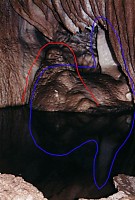 Buddha/Bull |
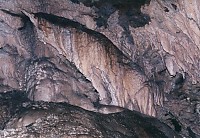
The Wolf |
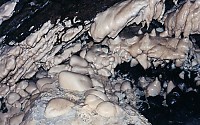
Wonderbread Room |
The riverbend cave has many examples of common rock formations found in
most Karst Caves in BC. The first examples are caused by water saturated
with calcium carbonate coming out of the rock and depositing on top of existing
rock. The white portions are almost pure calcite, while other minerals,
mostly iron, make the orange and red stains.
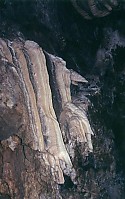 Ribbons (Bacon Strips) |
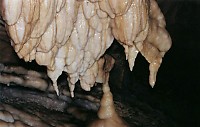
Flow Stone |
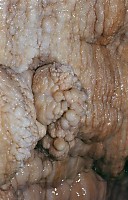 Brain Rock |
The next phenomena we were we shown was Soda Straws. These are found
in most caves and are formed when water collects and slowly drips off a point
on the roof. Soda Straws are probably the most delicate and definitely
the fastest growing structures in the caves. Our guide told us that
straws can grow at a rate up to centimeters a century (fast for caves).
Some times Soda straws will plug and then start start to form columns.
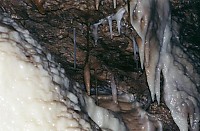 Straws coming off roof. |
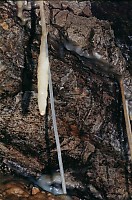 Blocked Soda Straw |
The next formation is Columns. These are Stalactites (from the the
roof) and Stalagmites (from the floor) that have met in the middle.
The Horne Lake cave has a particularly nice formation called the cage which
is a long series of columns close together.
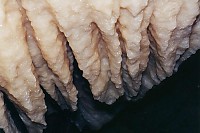
Cage from Above |
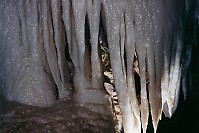 Cage with side lighting |
The next formations are caused when water starts to pool. Flow pools
are similar caused by pools of water saturating with calcium carbonate and
then the calcium carbonate coming out of suspension. The pools seem
to go in one of two routes - either they form geometric patterns of rock
or rounded pearls. Flow pools are built with thin layers of calcite
that forms on the surface of pools as they evaporate. As they float, more
and more calcite attaches to it in circular patterns. These "cave rafts"
continue to float on the surface of the water as long as it is undisturbed
until they reach a weight that pulls them under.
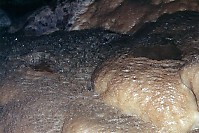 Flow Pools |
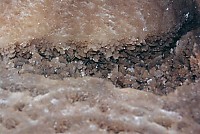 Dry Flow Pool |
The other option for water pools is to form pearls. They are formed
in pools of water and I'm guessing that the the pearls start nucleating on
existing rock and new rock is uniformly deposited around them. The
important part is that there is dripping water falling into the pool - if
the water was too flat you would get flow pools.
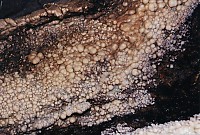
Pearls |
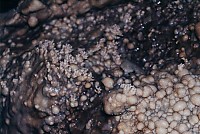 Pearls in Detail |
While I'm sure there are many more types of rock formations (and many unique shapes in caves), we hand only a limited time under ground and all too soon we had to return to the surface. I look forward to my next trip underground!
There are lots of great online resources about caves. One I used in preparing this page is:
